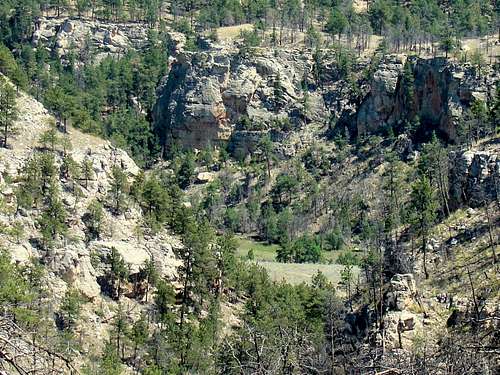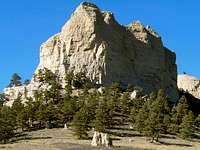-
 9754 Hits
9754 Hits
-
 81.84% Score
81.84% Score
-
 14 Votes
14 Votes
A Long-Standing Controversy
It can be rather disappointing to spot a majestic summit or view a beautiful canyon only to find out it is “off-limits” due to private property restrictions. In some parts of the world, such restrictions are almost non-existent. Here in the USA though, property owner’s rights give them almost monarch-like rights in many locations. And many times private property owners are unwilling to allow access on their lands. This leads to frustration on the part of responsible hikers and climbers who, though they practice good ethics, are still shut out. Consider the comments posted on the page for Step Mountain, Utah. This reminds me of my 1979 hike up Topaz Mountain, near Delta, Utah, which was open to the public long ago, but is now largely shut off due to private mining restrictions. The very far-reaching topic of private property restrictions is large enough that volumes could be written about it. Obviously, one article on SummitPost will only be able to touch onto some of the key issues surrounding the matter, and provide a base for member’s observations. The forums of SummitPost have also seen plenty of comments on aspects of these issues. Restricted land access is an issue that also reaches beyond the scope of hiking and climbing and is evidenced by articles like this one in the High Country News (Montana) Private property blocks access to public lands. Liability issues and frivolous lawsuits do have an impact on property owners’ decisions.
It has been observed many times that freedoms abused are often freedoms lost. In the Black Hills, where I live, several examples come to mind. Parker Peak is the Fall River County highpoint. It is on public land, but entirely surrounded by private land. The owners of those private lands are not usually inclined to grant permission to cross their property, due to the damage that has been inflicted in the past by irresponsible people crossing those lands. Just to the west of Parker Peak lies the former Fossil Cycad National Monument, which had to be closed in 1957, due to vandalism and looting. Further west is Craven Canyon, the site of many ancient petroglyphs and which have also been vandalized. The forest service, in an effort to protect the remaining artifacts, has closed the forest service roads into the canyon and stopped giving out maps or instructions on how to find the petroglyphs. While the land remains open to the public, it is unfortunate how the actions of a few harebrained individuals negatively affect the rest of society in such large ways. Perhaps the problem of private land access does not seem so large to people who live in an area rich with great public lands access opportunities, like Colorado. However Nebraska, Colorado’s neighbor to the northeast, is not so fortunate. Public lands comprise a very small percentage of Nebraska and as expected the access to the private lands is usually quite restricted. According to Private and Public Lands Percentage statistics from the US Census Bureau, only eight states have more than 50 percent public lands. It is important to know ways to obtain permission to access private lands around the nation.
Some Ways to Access Private Lands
While getting permission to access private land is the key requirement in planning a private land outing, finding out who actually owns that land would be a prerequisite to that. If you live in the area, you may already know who owns the land. However, most hikers and climbers have to “play detective” and do some research to find those owners. It’s not always possible to get permission at the nearest cabin or ranch house. Sources for land ownership information are generally available from the county courthouse in the county which the land is situated. Published plat maps are sometimes also available outside of courthouses – often from area publishers or news offices. Local sheriff’s departments are often a good source of information on ownership, plus advice on those intangible elements that can greatly affect your plans, like vicious dogs, large populations of rattlesnakes, loosely-covered abandoned mines, unfriendly owners, etc. If there is a local forest service office, they generally can pass on helpful information as well. Fish & Game officers are another good source of information. Some states have online land ownership maps that can be helpful also. Once you determine who owns the land, you will need to contact the owners. Often that is easier said than done. Tracking down owners addresses and phone numbers will at least require some Google skills, unless you obtained your information from a public agency or officer. If contacting Black Hills landowners is typical at all, you may find some owners who never answer their phones – possibly attributable to caller ID. So, you may have to go to the owner’s home or place of business in person and seek permission. Certainly, if you do not want to get in trouble or ruin the chances for other hikers, you will need to abide by all rules the owner requires for using the private property.
Some Examples
SummitPost has numerous pages that illustrate some of the private property issues that hikers and climbers encounter. Four are included below:
Crow Butte, Nebraska offers probably the best private land climb in the state. The two landowners that control most of the access will occasionally allow climbers to cross their land. This is rather amazing, given the fact that on several occasions hikers and climbers have left cattle gates open and allowed cow herds to escape. Further, one group set up a camp on one ranch property and cut down a tree for firewood – all this without permission. Generally, the national forest service office in Chadron will help interested climbers contact the landowners. Inyan Kara Mountain, Wyoming is a remote and very unique summit in the western portion of the Black Hills. Like Parker Peak, the summit is on public land. Also like Parker Peak, there is no way to access the peak without crossing private land. Generally, this requires some diplomatic help from the forest service. Still, this is not a guarantee that access will be granted.
Catholicon Mountain, South Dakota is part of the Seven Sisters Range southeast of Hot Springs. The whole mountain is private property parceled out between multiple owners. Not only is this complicated, but there is a long-standing local tradition dating back to the late 1800’s whereby locals hike to the summit whenever they want (usually to bushwhack from the northwest). For those who attempt to contact any of the owners for permission, normally the Allen Ranch (northeast side) is the only one that responds. If you have a personal standard that absolutely requires you get permission before hiking, the Allen Ranch is probably your only option. The Seven Sisters Northern Route that you would use from the Allen Ranch to the western ridge line is also the route that would open up access to summits south. Devils Slide Mountain, South Dakota is owned by the Nature Conservancy, so is often available for public hiking and climbing. However, they do close access at certain times of the year – usually during local hunting seasons. Therefore it is essential to contact their office before planning an outing there.
Cultivating the Goodwill of Private Landowners
It’s amazing how quickly a few bad encounters can close access to private lands, and how difficult it is to reverse that. Practicing good manners when contacting property owners will always be better-received that a cocky or rude demand for access. Please remember that a private property owner who allows you access is doing you a favor. Keeping the good will of private property owners should include some common sense guidelines, such as: 1. Practice the “Leave No Trace” ethic. Pack out what you pack in. 2. Leave things the way you found them. Close gates after yourself. 3. Do not start any fires or build a campsite unless you have express permission to do so. Cigarettes also make some landowners nervous – especially in dry western states. 4. Do not allow your dog to run free – especially if there is livestock that can be spooked. 5. Do not disturb the quiet of the property. Fireworks, shouting and screaming, barking dogs, loud radios, etc. all can make some owners sorry they allowed access. 6. Do not discharge any firearms on the property unless you have worked out a specific agreement with the owners. 7. As much as you may think you need one, please wait until your get back from the outing for your alcoholic beverage(s). You may know you can handle it, but chances are many private property owners have encountered others who can’t handle their liquor. Of course, your views may vary greatly with the opinions and requirements of private property owners. It’s a free country and you are not obligated to hike their land, just like they are not obligated to grant you access. Hopefully though, you will find many great private land opportunities that will be agreeable to you.









